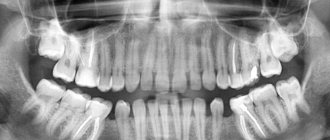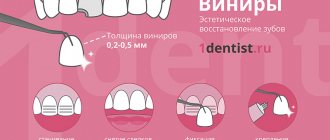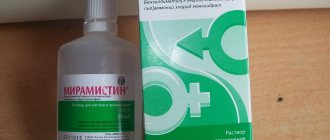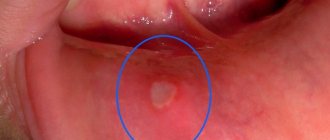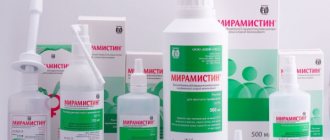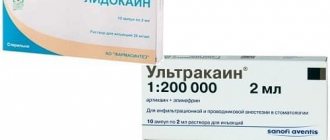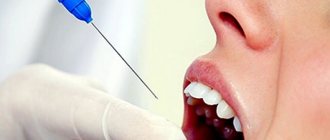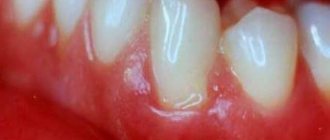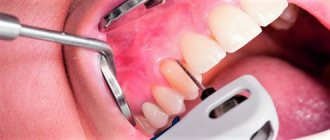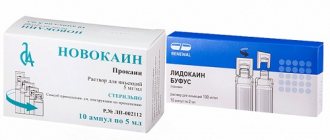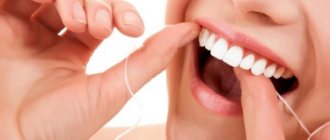What can I do to make the anesthesia wear off faster?
- Before visiting the dentist's office, you should avoid eating heavy foods and alcoholic beverages for some time. You should also not take medications unless they are prescribed by a doctor and taken according to a specific regimen.
- After simple dental procedures, warm drinking and light massaging in the numb area will help you recover from freezing faster.
- If the intervention was serious (tooth extraction, drainage, pulp opening), then you should neither drink nor touch the treatment area. You should not drink for an hour after surgery, and you should not eat food for 4-5 hours.
If the effect of the painkiller does not wear off for a very long time, then this is a reason to contact a specialist again. During the operation, any nerve may have been affected.
Side effects
When used by injection, Lidocaine can cause skin itching, hypotension, insomnia, shortness of breath, headache, weakness, digestive problems and other negative symptoms. Spray treatment may cause tingling, redness, swelling, hives and other local reactions.
Any negative phenomena during the use of the drug must certainly be recorded by a doctor and eliminated in a timely manner so that they do not affect the condition of the fetus.
What affects the duration of anesthesia?
The duration of exposure of the human body to various drugs varies within certain limits. One frost goes away quickly, the other persists for a long time.
How long it will last depends on the drug. For example, Novocaine provides pain relief for an hour, after an hour everything goes away. The effect of Lidocaine lasts somewhat longer, it lasts 2 hours.
When using Articaine, freezing takes from 2 to 4 hours.
In addition to the drug, the duration of anesthesia is influenced by the anatomical features and condition of the patient himself:
- the abundance of blood vessels in the anesthesia zone contributes to faster removal of the frost;
- liver and kidney diseases, on the contrary, make it difficult to remove the anesthetic, the effect lasts longer; can be not only local, but also systemic in nature;
- the patient's excited state stimulates the production of adrenaline, which prolongs the duration of the anesthetic;
- Consumption of heavy fatty foods and alcohol, as well as some medications, additionally loads the liver and prevents it from coping with the injected anesthetic.
For what throat diseases in children is it prescribed?
Throat spray with iceocaine is prescribed to children over 3 years of age for the following indications:
- when correcting the nasal septum (due to a curved nasal septum, the mucus in the nose becomes thicker, which is why, flowing down the back wall of the larynx, irritates the throat, causing pain in the child and the urge to dry cough);
- during surgery to eliminate the pharyngeal reflex;
- if it is necessary to insert an injection needle during an operation to remove tonsils (the main indication for tonsil removal is chronic tonsillitis in a child, which, in the absence of timely treatment, can lead to damage to the skeletal system of a small person);
- the need to open peritonsillar abscesses;
- the need for puncture of the maxillary sinus;
- symptomatic treatment for pharyngitis;
- symptomatic treatment for laryngitis;
- symptomatic treatment for tonsillitis;
Throat spray with lidocaine is used to relieve sore throat, for example, with sore throat - symptomatic treatment for laryngotracheitis;
- hoarseness or hoarseness (including due to the nature of the professional activity of teachers, announcers, and so on);
- aphthous stomatitis;
- gingivitis;
- thrush, characterized by fungal infections of the mucous membranes of the mouth and throat;
- catarrhal sore throat.
The dosage of ice-caine sprays is determined by the doctor after examining the small patient, taking into account the symptoms and severity of the diagnosed disease. Incorrect dosage calculation will not only significantly reduce the effectiveness of the therapy, but can also provoke intoxication due to the vulnerability of the child’s body.
Types of anesthesia
Sometimes dental treatment occurs under general anesthesia. This need arises in advanced cases when it is expected to process a large number of units in one session. However, it is preferable to use local anesthesia, which is less harmful to the body. There are several types of local anesthesia:
- Application anesthesia is anesthesia by wetting surface tissues with a drug without introducing it orally. Often such freezing precedes the injection and makes it less painful. Superficial anesthesia is used when cleaning teeth from stone and some procedures related to the treatment of gums.
- Infiltration anesthesia is used in the treatment of deep caries. The drug is administered by injection into the area of the tooth root in its upper part. The anesthesia is local in nature: one tooth and a small area of gum lose sensitivity.
- Conduction anesthesia spreads to the nerve bundle. The injection is made in such a way as to numb a large area of the gums and several teeth. This is necessary when opening an abscess, treating periodontitis and in other cases of serious damage to the tissues of the oral cavity.
- Intraligamentary anesthesia is used when it is necessary to numb only the tooth without affecting the mucous membrane. This is to avoid biting the gum or cheek due to numbness. An anesthetic is injected into the periodontal ligament between the alveolus and the tooth root.
- Trunk anesthesia is necessary when performing operations on the jaw, in case of maxillofacial injuries. It is performed only in a hospital setting. An anesthetic injection is given in a specific area at the base of the skull. This type of freezing lasts a long time and is very effective.
- Intraosseous anesthesia is effective in treating or removing a tooth if infiltration and conductive freezing do not give the desired result. It is carried out in two stages: first, the gums are anesthetized, and then an injection is made into the jawbone area between the treated units. The loss of sensation occurs instantly, but does not last long.
We suggest you read: Are children given anesthesia for dental treatment?
When is it prescribed?
Lidocaine is most often used for anesthesia during a variety of surgical interventions and procedures. Gynecologists use this drug for various manipulations, for example, if a woman needs to install a pessary or put stitches on the cervix.
Dentists use Lidocaine for pain relief during the treatment of caries and tooth extraction. The spray is sprayed onto the oral mucosa before injection anesthesia, suturing, removing tartar, installing dentures or crowns, and the solution is injected into the gums. ENT doctors can prescribe Lidocaine for manipulations and operations in the nasal area.
Ophthalmologists prescribe an anesthetic to expectant mothers during surgical procedures in the area of the visual organs. Traumatologists, surgeons and neurologists use Lidocaine to block nerves, treat wounds and burns, and provide superficial anesthesia for interventions on the skin and muscles. The drug is prescribed for sprains, dislocations and other injuries.
Another option for using an injection solution is to add it to antibacterial medications, the injections of which are very painful. However, from a safety standpoint during pregnancy, such use of Lidocaine is undesirable. Many women also use the spray during depilation, but due to the high risk to the fetus, this option should also be abandoned.
Freezing drugs
Among the list of tablets for toothache in adults, there are also drugs with a freezing effect that help dull the pain in a short time. Some people prefer them due to the extremely fast action of such products. In addition, many of these products are suitable for children.
- Kamistad. This drug is based on lidocoine, one of the strongest local anesthetics. For severe toothaches, it can be used by adults and children without liver disease, which is a contraindication.
- Dentol. This remedy is suitable even for very young children who are teething; it helps with inflammatory processes in the gums.
- Gel Metrolgin. This ointment is best used for pain caused by gum disease. However, it can also be used for ordinary toothache.
The Pentalgin tablet also has a freezing effect. However, it does not need to be taken orally; for toothache, you need to hold the tablet, broken in half, next to the painful tooth. After some time, such a compress will create a feeling of freezing.
Approximate price and reviews
The cost of Lidocoin depends on the form of release of the product and may change over time.
Approximate prices that are current today are given below:
- A package, including 10 ampoules with a solution, costs about 50 rubles.
- The cost of one capsule with solution is about 70-80 rubles.
- A 50ml spray can costs about 350-400 rubles.
- A tube of gel costs about 200-250 rubles.
Read also: Dental drops for children
Reviews:
Anatoly: “The drug Lidocoin often came to the rescue in our family: it helps me and my father with sudden toothache. My wife also uses it from time to time, but not for dental purposes; she says that it helps to endure epilation painlessly.”
Elena: “I began to actively use Lidocoin spray when my son grew up and he began to develop a large number of painful bruises and abrasions after falls. The last time I decided to use it to relieve my toothache, but the side effects were too pronounced, primarily a strong feeling of nausea. For this reason, I am now looking for analogues with a milder effect.”
Freezing agents
You can quickly and effectively, albeit for a short time, eliminate toothache by using a freezing gel. The product is effective, causes virtually no side effects, and has far fewer contraindications than tablet medications.
https://www.youtube.com/watch?v=eLnNkB6VYpw
Quick-acting freezing gels used to relieve toothache include the following.
- Kamistad - contains lidocaine and hydrochloride.
Relieves pain within five minutes. The action lasts about two hours. Not recommended for pregnant and lactating women, people with liver/renal insufficiency, and hypertensive patients. Kamistad - Dentol contains benzocaine.
A fast-acting remedy that is used even for children when cutting their first teeth. Begins to act in 2-3 minutes. The effect lasts an hour and a half. Dentol - Metrogyl Denta - consists of metronidazole and chlorhexidine.
Relieves pain in many dental diseases: stomatitis, periodontal disease, periodontitis, gingivitis and inflammation of the oral cavity after wearing dentures. Lasts for about one and a half hours. Metrogyl denta - Kalgel - consists mainly of lidocaine.
It can be used in infants, during teething, and in pregnant women. It has an instant freezing effect that lasts up to two hours. Kalgel
Today, you can easily find a variety of painkillers in the pharmacy. Some of them should always be with you. It is better if these are not randomly selected drugs, but those that act specifically on your body and do not cause harm.
It is also necessary to understand that no matter how effective the medications are, the problem with your teeth will not disappear if you manage to relieve the pain for a while. The best and only correct way to get rid of toothache is to visit the dentist. Then you won't need pills.
Lidocaine for tooth extraction in pregnant women
Using medications while expecting a baby is always associated with additional concerns regarding their safety for the developing child.
At the same time, there is hardly a pregnant woman who, in all 9 months, has never resorted to the help of one medicine or another. Lidocaine is a local anesthetic drug. His help is often sought during dental and gynecological procedures and minor surgical interventions.
Is this drug the drug of choice while expecting a child? Can Lidocaine be used during pregnancy?
The active component of the drug is the substance of the same name, lidocaine hydrochloride. Once in the body, the drug has a pronounced anesthetic effect. The “work” of the drug is based on reducing the excitability of nerve endings.
Regardless of the method of use of the medicine, Lidocaine overcomes the placental barrier, which means it will reach the baby in the womb. Lidocaine allows both local application (on the surface of the skin or mucous membrane) and injection administration (intramuscular or subcutaneous).
In the first case, you should use the dosage form in the form of a spray or gel, in the second - the drug in ampoules.
According to the instructions for the drug, Lidocaine is contraindicated for use while waiting for the baby. However, cases where this drug was used for anesthesia in pregnant women are not so rare. Is the medication really suitable for use during pregnancy?
Lidocaine during early pregnancy
The first trimester of gestation (before the 12th week of pregnancy) is the most dangerous in terms of the use of any medications. The child’s body is just beginning to develop, so chemical compounds can cause irreparable harm to it. The most dangerous period is from 2 to 8 weeks of gestation, because
the drug can have a teratogenic effect (provoke deformities, as well as dysfunction of organs and systems). Another danger lies in the threat of increased uterine tone. As a result, there is a threat of spontaneous pregnancy loss. Therefore, the use of lidocaine in the first trimester of pregnancy is strictly prohibited.
The only exceptions may be urgent interventions.
Lidocaine during pregnancy in the second trimester
The second trimester of pregnancy is the safest for many interventions. Regarding the use of medications, restrictions on many of them are also becoming less stringent.
This is due to the fact that the baby has already formed by this period, so negative effects on his body are practically excluded. Another factor is a decrease in the uterine sensitivity to external influences.
The most common reason for using lidocaine during this period is the need for dental intervention.
The severe pain that a pregnant woman may experience during treatment or tooth extraction can cause much more harm to the pregnancy than the anesthesia administered. During this period, it is also recommended to carry out other planned interventions, the duration of which does not allow the end of pregnancy.
Lidocaine during pregnancy in the third trimester
The final weeks of waiting for the baby again call into question the possibility of using Lidocaine. During this period, the woman’s body experiences maximum physiological stress. The result of using the drug may be premature onset of labor.
At the same time, it is worth taking into account a possible reaction to the drug from the woman’s body - a drop in blood pressure and oxygen starvation of the expectant mother can lead to a slowdown in the baby’s heartbeat and asphyxia. The doctor must constantly monitor the woman’s condition and respond to the slightest changes.
If the problem can be postponed for a while, it is better to return to it after the birth of the baby (especially if we are talking not about health, but about aesthetic beauty).
Lidocaine for toothache during pregnancy
Oral health is difficult to underestimate. The pain that occurs at the site of inflammation causes significant discomfort to the woman.
No less dangerous is the infection that has accumulated in the affected area. In this case, you should under no circumstances hesitate to contact the dentist.
Even if a woman does not experience acute pain, it is strongly recommended to visit a doctor if she has the following conditions:
- Periodically occurring or constant pain in the teeth (even of mild intensity).
- Bleeding gums.
- Increased sensitivity of teeth, manifested in pain when eating hot or cold food (or drinks).
A timely consultation with a dentist will help you adjust your oral care, thereby preventing the need for more radical intervention, incl. and with the use of anesthesia. During pregnancy the following treatment is allowed:
- Caries (resolution of hard dental tissues).
- Stomatitis (inflammation of the mucous tissue lining the oral cavity).
- Gingivitis (inflammation of the marginal surface of the gum).
- Pulpitis (inflammation of the internal tissues of the tooth).
Tooth extraction is allowed only if the latter are painful. An exception is wisdom teeth, because... their extraction is often accompanied by a complicated recovery period. So that tooth pain does not come as a shock and surprise to you, be sure to sanitize your oral cavity at the stage of pregnancy planning.
In dental practice, when treating pregnant patients, Lidocaine is used (if the doctor chose this drug) in the form of a spray (from 1 to 3 doses), as well as in the form of injections. It is worth considering that the area that needs to be numbed with the spray should be small, and the anesthesia time will last about 5 minutes.
The medicine can be used no earlier than 16 weeks of gestation. The use of lidocaine during pregnancy for dental treatment in the form of “conduction” anesthesia is strictly not recommended. The dose of the drug is calculated based on the body weight of the pregnant woman. The maximum permissible dosage for an adult is 4.5 mg/kg.
How does lidocaine affect pregnancy and the fetus?
Lidocaine cannot be considered an absolutely safe drug, but panic after a single use of the drug (not earlier than the second trimester) should not be caused either. The main concerns associated with the use of Lidocaine are based on its ability to easily penetrate the placental barrier, and therefore into the baby’s body.
- The use of anesthesia in the first weeks of pregnancy can cause congenital deformities. The use of lidocaine even externally during early pregnancy is strictly not recommended.
- At later stages, it is necessary to be extremely careful if there is a tendency to arterial hypotension. A dangerous decrease in a woman’s blood pressure can lead to oxygen starvation of the baby.
- Exceeding the permissible dosage can lead to the development of bradycardia in a child.
- Using the product after 28 weeks of gestation may cause premature birth. In the last months of pregnancy, a woman’s abdominal organs experience maximum pressure from the uterus, and blood flow may be disrupted. Pressure in the epigastric area often provokes tightness of the thoracic region, and the pregnant woman may experience shortness of breath. The use of Lidocaine can cause difficulty breathing, decreased blood pressure, and muscle spasms. The listed phenomena can seriously disrupt the course of pregnancy and lead to its completion ahead of schedule.
Contraindications to the use of Lidocaine (spray, injection) during pregnancy
Before using any drug, the doctor should check with the woman for possible contraindications. For Lidocaine, this list is as follows:
- Individual hypersensitivity reaction.
- Low blood pressure.
- Pathologies of the liver and/or kidneys.
- Disturbances in the functioning of the cardiovascular system.
Lidocaine during pregnancy - reviews of the drug
Despite the restrictions on the use of Lidocaine during pregnancy, many doctors still use this drug for anesthesia during various medical procedures. The experience of most women who have already given birth is based on a single administration of the drug.
No negative phenomena were noted, the children were born on time and without developmental deviations. A number of women noted that the drug was prescribed as part of an antibacterial “cocktail” in the second half of pregnancy.
There were also no significant negative consequences noted.
To summarize, it is worth noting that despite the warnings of the drug manufacturers, the drug still finds use in such a category of patients as pregnant women. It is difficult to answer for sure whether Lidocaine is harmful during pregnancy.
While there are potential risks from exposure of the drug to the baby in the womb, there is no statistical data regarding a higher number of complicated pregnancies after a single use of Lidocaine.
The drug is a drug of last resort, so you should not use it unless absolutely necessary, especially since the modern pharmaceutical market can offer safer alternatives (for example, Ultracaine).
Source: https://www.kosmetik-dent.ru/lidokain-pri-udalenii-zubov-u-beremennyh/
Freezing during pregnancy
Dental anesthesia can be administered to pregnant women starting from the second trimester. In this case, the most modern means that are safe for the fetus should be used.
Of course, any dentist recommends dental treatment in advance of pregnancy.
If you still need to treat your teeth, then it is optimal to do this in the second trimester of pregnancy. Of course, if necessary, the doctor will provide first aid to the patient at any stage of fetal development, but as a result, there are certain risks.
We suggest you read: How often should you remove dentures?
Tooth freezing for a pregnant woman is carried out using the most modern means that do not contain adrenaline, which can cause an increase in blood pressure and contraction of the uterus in the patient.
Dental treatment is carried out using non-toxic drugs, traumatic interventions are avoided, and in some cases the procedure is carried out in a hospital setting.
Instructions for use
Lidocaine injections are used in emergency cases in a dose that is calculated for each woman separately, taking into account her body weight. A medical professional should inject a pregnant woman. "Lidocaine" in the form of a spray is applied externally, and the dosage is also determined individually. During pregnancy, the doctor prescribes a dose that will provide satisfactory anesthesia, but will be minimal. Dentists usually use 1-3 sprays, ENT doctors - 1-4 sprays, gynecologists - 4-5 sprays.
How to remove the freeze?
Typically, to reduce discomfort after treatment, the patient is recommended to apply warm compresses to the numb area. There is no need to warm the cheek if a tooth has been removed, but applying a warm handkerchief ironed with an iron is quite acceptable.
Blood vessels dilate under the influence of heat, the activity of processes increases, and anesthesia passes faster. It is impossible to remove the freeze with any medicine. Until the substance introduced into the tissue dissolves and resolves, the numbness will not go away.
How to remove frost at home: only a warm drink or a warm compress on the injection area can somewhat reduce the discomfort and speed up the process.
Dental treatment under general anesthesia
General anesthesia (anesthesia) is rarely used in dental practice. Conventional tooth freezing is most often used. General anesthesia is used only if serious dental work is to be done. The effect of anesthesia lasts approximately 6 hours, during which time the patient remains unconscious.
Using general anesthesia for pain relief in dental treatment has some advantages:
- Tooth extractions or other procedures can be done in one go. There is no need to return to the dentist for further treatment;
- Dental treatment under general anesthesia is absolutely painless. In addition, the chance of any infection getting into the wound is reduced;
- When treating teeth under general anesthesia, substances that block the formation of saliva are used.
However, the use of anesthesia has many contraindications: mental instability of the patient, intolerance to anesthetics, allergic reactions. Therefore, the main method of pain relief during dental treatment in dentistry is local anesthesia.
How to use lidocaine spray for toothache
Lidocaine spray has a 10% concentration of active ingredients, due to which the painkiller acts almost instantly. The effect occurs within a minute after using the spray. However, the duration of action is only 5-6 minutes. Therefore, in dentistry it is often used for superficial anesthesia.
For pain relief, three presses on the bottle button are enough. If we talk about medicine in general, then the maximum number of sprays should not exceed 40 presses with a patient weighing about 70 kg. You can also apply the product to a cotton swab and apply it to the inflamed area.
Important! Immediately after spraying, the patient may notice a slight burning sensation in the area where the drug is distributed. This is not necessarily an allergic reaction - it is a normal consequence of using the drug.
Lidocaine can be purchased at a pharmacy and you do not need a prescription from your doctor. The cost of the spray varies from 300 to 400 rubles.
Features of the use of anesthesia in dentistry
So, there are two large groups of local anesthetics - application and injection. The first is well suited for anesthesia directly at the injection site, the second - already during direct intervention.
But freezing sprays have their own contraindications - they cannot be used for children under five years of age, as well as for adults suffering from bronchial asthma. Gels and sprays are used for certain indications, for example, during difficult teething in children, with stomatitis, after various injuries, to relieve pain from erosions and ulcers.
Experts advise that if you know that freezing usually does not affect you as much as you would like, try taking additional sedatives (tincture of motherwort, peony, valerian) before visiting the dentist.
And if you suddenly feel that not only the desired area is numb, but also your cheek, tongue or lips, do not be alarmed. This occurs due to the close exit of the nerve endings towards each other and the contact of the painkiller used on them.
Using lidocaine-based spray
Before applying the spray to reduce sensitivity on the penis, the organ must be washed and blotted with a towel. Then the aerosol should be applied evenly to the surface of the head and left to absorb for 10 minutes.
When you begin to feel that the head is numb, the remaining lidocaine should be washed off with water, then it is advisable to put on a condom.
If the remaining product is not washed off the penis, then during intercourse it will also affect the woman’s vaginal mucosa, reducing her pleasant sensations from sex. And if sex is oral, lidocaine will simply “freeze” her tongue and oral cavity.
It has been proven that an anesthetic spray for the head of the penis does not affect the integrity of the condom. A condom should be used not only to ensure that lidocaine does not get into the vagina. But also because the condom itself somewhat prolongs sexual intercourse.
These are the general rules for using lidocaine sprays. Each specific product must be accompanied by instructions that describe in detail how to use this product, how to apply it and the duration of action.
WE ADVISE!
Weak potency, a flaccid penis, and the absence of a long-term erection are not a death sentence for a man’s sex life, but a signal that the body needs help and male strength is weakening. There are a large number of drugs that help a man gain a stable erection for sex, but they all have their own disadvantages and contraindications, especially if the man is already 30-40 years old. Eroxin not only helps to get an erection HERE AND NOW, but acts as a preventive measure and accumulation of male power, allowing a man to remain sexually active for many years!
Read more…
Drugs with a freezing effect
Such remedies help eliminate dentalgia for a long time; they are used topically and in most cases are available without a doctor’s prescription. The most effective and popular are:
- Kamistad. It should not be used by women carrying or breastfeeding a child; another contraindication is individual intolerance to the components. Kamistad can and should be used not only for dentalgia, but also for any other dental diseases. A small amount of gel is applied directly to the painful area and the tissue around it. It is not recommended to consume food or water for the next 20 minutes.
- Dentol is another freezing gel made from benzocaine. The main indication for its use is toothache of any origin. It should not be used if the oral mucosa is severely injured, there is an individual intolerance to the components, and if the pain is caused by a strong open focus of inflammation.
- Cholisal has not only a freezing and analgesic, but also an antimicrobial effect. It is used for almost any dental disease. You cannot use it if you are intolerant to some of its components. Use with extreme caution in children under 1 year of age and in pregnant women. Apply the gel in a strip of up to 1 cm directly to the painful area two, maximum three times a day. It is recommended to use the product immediately after meals and before going to bed.
All medicinal freezing agents are produced in the form of thick and almost transparent gels. They are easy to apply and allow you to completely eliminate pain for a long time.
Kamistad gel
We suggest you read: Is it possible for pregnant women to have their teeth treated under anesthesia and 5 more questions. Anesthesia, dental pain relief during pregnancy
Pros and cons of the drug
Lidocoin gradually replaced another drug, Novocoin, from dental practice, which was also used to reduce toothache.
This happened because it has the following positive aspects:
- A successful combination of a high degree of efficiency, safety and speed of action. According to these indicators, Lidocoin is several times superior to other pharmacological drugs of the previous generation that were used for pain relief.
- Duration of action, which can be 1.5 hours. This is quite enough to seek urgent dental care to eliminate the causes of sudden acute pain. In some cases, the effect of the drug can be reduced to half an hour, this depends on the individual characteristics of the body and the location of the source of pain, since these factors determine the rate of leaching of the active substances from the tissues.
- Availability of budget forms of the drug: the solution in ampoules is in an affordable price range, so anyone can purchase it.
- The solution, sold in carpules, is used by specialists during dental treatment. This form makes it easier for the dentist to administer anesthesia, and thin needles actually do not cause additional pain to the patient when administering the product.
- The spray is very convenient to use both to eliminate acute pain and during dental treatment. At the same time, the product in this form reduces the risk of a gag reflex when performing various manipulations in the oral cavity. In addition, its use allows you to reduce the pain from the subsequent injection.
- Possibility of using the drug in the form of a spray or aerosol during pregnancy.
However, Lidocoin also has a number of certain disadvantages, which are discussed below:
- This drug is inferior to many analogues that appeared on the pharmacological market after it. Today there are many modern means that surpass it in strength and duration of action.
- It is impossible to use Lidocoin in any form during breastfeeding.
- The product, produced in the form of a spray, has a fairly high price. The drug in carpules will also cost several times more than the solution sold in regular ampoules.
- The presence of contraindications that may prevent this method of pain relief.
- There is a possibility that to purchase Lidocoin at a pharmacy you will need a prescription written by a specialist.
Read also: Solcoseryl oral gel
Types of modern anesthesia
First, let’s talk about the principle of action of any local anesthesia - the injected substance directly affects the nerve impulse, which is responsible for pain. Any drug has an expiration date, gradually dissolving, it ceases to affect the body, unpleasant sensations appear for a while, then disappear.
The following types of anesthesia are used today:
| Applique. | These are special sprays or gels designed to additionally relieve discomfort; the duration of action is short. |
| Infiltration. | It is used for cleaning dental canals, it is injected under the periosteum, the mucous membrane of the gums, intraosseously, the action time is 1 hour. |
| Conductor. | Features: injection into the trigeminal nerve area. This type of pain relief is indicated for extraction, treatment of molars, nerve removal, gum surgery, and other complex and lengthy manipulations. |
| Intraligamentary. | Anesthesia is injected around the desired molar with a special syringe. It is used for the removal of wisdom teeth, and during complex manipulations it enhances the effect of other painkillers. |
Pharmacodynamics and pharmacokinetics
The local anesthetic and antiarrhythmic properties of the drug are based on stabilizing neuronal membranes and reducing the degree of their permeability to sodium ions. This prevents the generation of action potentials and the transmission of impulses. A decrease in sensitivity occurs after lidocaine is hydrolyzed in a slightly alkaline environment.
The use of the drug for anesthesia of the pharynx and nasopharynx has a number of features. Lidocaine causes a number of reactions that are important to always remember. Once on the oral mucosa, the medicine suppresses the pharyngeal reflex. Next, the active substance reaches the larynx and trachea. Penetrating into the mucous membranes of these organs, Lidocaine significantly slows down the cough reflex, which can lead to bronchopneumonia. The analgesic effect of the drug in aerosol form does not last long and completely dissipates within 15 minutes.
When it comes into contact with the mucous membrane, the product is absorbed very quickly. The rate of absorption directly depends on the intensity of the blood supply, the total volume of the drug dose, the location of the treated area, and the duration of application. After applying Lidocaine to the mucous membranes of the upper respiratory tract, part of the substance is swallowed, enters the gastrointestinal tract and is inactivated there. The maximum concentration of lidocaine on the target area of the mucous membrane is achieved after 8-12 minutes.
